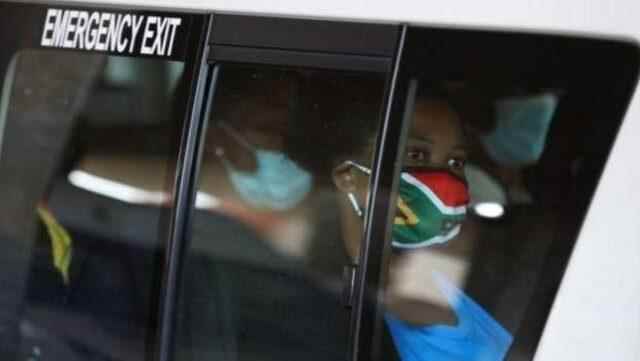We came back to a familiar point. Again, a new variant of the coronavirus is causing concern.
For B.1.1.529, which originated in South Africa, the most recently detected and most mutated variant ever seen, one scientist I spoke to said, “Terrible.”
Attention is drawn to the potential of B.1.1.529 to be the most dangerous variant ever seen.
The variant has just emerged and most of the detected cases are still concentrated in one region of South Africa. But there are also some hints that the variant may actually have spread more widely.
Many questions come to mind, such as how fast this new variant is spreading, how far it can exceed the protection of vaccines, and what to do.
We can only answer most of these with the ideation method.
What is known about the variant?
The World Health Organization will name the variant today with a letter from the Greek alphabet, just like its predecessors (Alpha, Beta, Delta).
The most important information about the variant is that it mutates a lot.
Professor Tulio de Oliveira, head of the South African Center for Disease Control and Research, said there was an “unusual combination of mutations” in the variant.
“This variant is very different from the variants that were in circulation before,” said Professor Tulio de Oliveira, adding:
“The variant took us by surprise. It’s a big leap forward in evolution, and it mutated in many more ways than we expected.”
Explaining the findings at a press conference, Oliveira said that there are 50 mutations in the variant, and more than 30 of them are found in protein protrusions on the outer surface of the virus.
These protrusions play a vital role in allowing the virus to enter healthy cells in the body, and therefore current coronavirus vaccines aim to neutralize these protrusions.
When we look closely at the parts of the virus that make the first contact with our healthy cells, it is seen that there are 10 different mutations in this section compared to the original virus. Whereas, there were only two mutations in this part of the Delta variant, which was the last to spread rapidly in the world.
This level of mutation is thought to have likely emanated from a single patient who was unable to defeat the virus.

What properties of mutations are important?
In fact, not every mutation is necessarily negative. Here, it becomes important to understand exactly what these mutations do.
But the most important point of concern here is that the new virus is very different from the original that emerged in Wuhan, China. This raises serious doubts about how effective vaccines based on the Wuhan virus will be against the new variant.
Some mutations in the new variant were also seen in the old variants. This can give an idea of how these changes may have an impact on the new variant.
For example, a mutation called N501Y seems to make the virus spread faster. There are some mutations that make it difficult for the antibodies in our body to recognize the virus and weaken the effect of vaccines. But some mutations are completely unique to this last variant.
“These new mutations worry us that the variant may have increased transmissibility, increased human-to-human transmission ability, as well as enhanced ability to bypass the immune system more easily,” says Professor Richard Lessells of the University of KwaZulu-Natal in South Africa.
So far, many variants have appeared that look very scary on paper, but in practice it turns out that they are not dangerous.
The beta variant was seen as the most worrying new variant earlier this year because it was more advanced at overcoming the immune system. But in the end, the Delta variant, which came to the fore with its fast spreading feature, affected the whole world.
“Beta was able to avoid getting caught in the immune system. Delta was more contagious, with a weaker immune evasion. This last variant has the potential to be more advanced,” says Professor Ravi Gupta of the University of Cambridge, UK.
What does the current data tell us?
Scientific investigations in laboratories will give a clearer picture of the new variant. But maybe we can find answers to some questions more quickly by tracing the virus in the real world.
It’s still too early to draw conclusions, but the signs are worrying.
There are currently 77 confirmed cases of the new variant in the Gauteng region of South Africa. 4 cases were identified in Botswana and 1 case (one person from South Africa) in Hong Kong.
However, although the new virus has not yet been identified, there are some signs that it may have spread more widely.
This variant gives different results on standard tests (called S gene deficiency), which makes it easy to track down without genetic mapping.
From this point of view, it is thought that 90 percent of the cases in the Gauteng region may be from this variant and may even have spread to many regions of South Africa.
But that doesn’t give us information that the new variant spreads faster than Delta, or is more immune-compromised, more resistant to vaccines, or causes more severe disease.
Likewise, considering that 24 percent of the population in South Africa is fully vaccinated, it is not possible to say how effective the new variant will be in countries with higher vaccination rates.
So, despite the fact that there is a lot we know now that we don’t know yet, we are facing an alarming variant of the coronavirus. This requires careful and close monitoring of the new variant and seeking answers to important questions so that it can be determined which steps will be taken and when.
If there’s one thing the coronavirus outbreak has taught us so far, it’s that sometimes it’s necessary to act before all your questions are answered.
